Quiet, easy-to-move rigs for European markets
KCA Deutag and its sister company Bentec have introduced several new rigs to the European onshore market that are quieter than other rigs, easy to transport and require smaller footprints.
|
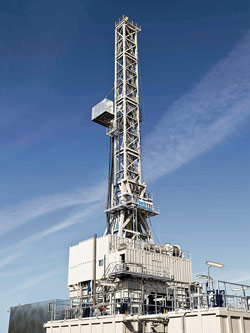
|
|
Bentec’s modular Euro-Rig is engineered with a box-on-box substructure, enabling quick and efficient rig moves on European roads with standard trucks.
|
|
Nederlandse Aardolie Maatschappij (NAM) recently contracted KCA Deutag to provide a Bentec-built T-700 heavy land rig designed specifically to operate within the strict European regulatory requirements. The highly automated rig follows Bentec’s Euro-Rig concept in designing for performance and safety, limited environmental impact, high mobility, modularity and flexibility.
The rig is equipped with the TD-500-HT top drive drilling system with a 450-tonne hookload capacity, 2,000-hp drawworks with regenerative braking system, power control and three T-1600-AC mud pumps. A new pipe handling system divides the handling process into two phases that work simultaneously and reduce trip time without compromising safety.
The box-on-box substructure and compact rig sections allow for easy transport and meet European road regulations and truck and crane standards. The rig’s design reduces noise levels to an attenuation of a maximum of 50 dB(A) at about 1,000-ft distance from the well center and a maximum of 80 dB(A) at a distance of 3 ft from the well center.
Bentec also introduced its Euro Rig in iterations of 250-, 350- and 450-tonne hookload capacity. The modular rig is engineered with a fast-move philosophy tailored to European markets. The containerized substructure, vertical lift mast, modularized mud tank system and optimized transport units allow for moving the 250-tonne capacity rig with about 40 truckloads within five days. The 350-tonne version can be moved with about 55 truckloads in five days.
The rigs’ modular substructure consists of four boxes and three drill floor parts with integrated drilling equipment. The boxes are used to house noise-emitting components such as the centralized hydraulic power unit. The integration of the drilling equipment in the substructure boxes and on the drill floor parts reduces rig move times since the equipment remains installed and internally connected during road transport.
The vertical lift mast consists of three units with an A-frame, with reduced dimensions of the main mast parts to allow for European road transport limitations. Integrated hydraulic winches are used to lift the mast. No exceptional road transport permits are required except for the drawworks and mud pumps. The rigs’ small footprint, 131 ft x 180 ft, reduces pad construction costs. The main drilling equipment is AC driven, although the rig can be built with DC drive if requested.
A planned 200-tonne design rig would include a Bentec TD-250-HT top drive and two Bentec T-1600-AC mud pumps. The mast height is 108 ft with a racking capacity of about 10,000 ft. The 350-tonne capacity iteration has three mud pumps and a 142-ft mast.
Additionally, Bentec’s new Speed Rig was developed with a 350-tonne hookload capacity for medium to deep wells, offering a small footprint and self-erecting design for quick transport and rig-up.
Two telescoping hydraulic cylinders lift the mast and substructure to the operating height. When the substructure is in the lowered position, the mast is connected to the drill floor. When the mast is in the vertical position, the hydraulic cylinders are disconnected and retracted.
A complete Speed Rig can be transported on 28 trailers. An optional rig moving feature enables the rig to be moved by two trucks in one piece with a lowered substructure and erected mast.
Multifunction vessel for remote, ultra-deepwater fields
The Dalian Developer has had a long history, beginning with its original concept as a multipurpose floater and spanning feasibility studies and technical case studies performed from 1996 to 2002. MPF Corp. was established with original funding in 2006 and ordered the hull, topsides and integration before encountering significant cost overruns and entering bankruptcy in 2008. In 2010, the new owner, Dalian Deepwater Developer Ltd., contracted Cosco Shipyard to complete the unit as an ultra-deepwater drillship under a fixed-price turnkey contract that calls for delivery in the third quarter of 2012. The shipyard contract calls for initially outfitting the vessel for drilling operations only. However, upgrades will be engineered to meet a client’s specific requirements in conjunction with a firm commitment.
|
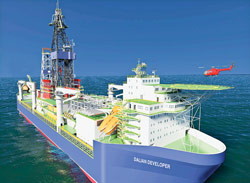
|
|
The Dalian Developer, currently under construction, is rated to drill to 35,000 ft in up to 10,000 ft of water. The design’s versatility enables the unit to be used in several modes, including an extended well test and early production unit, subsea construction vessel, and emergency response and containment unit in the case of oil spills.
|
|
The Dalian Developer is rated to operate in up to 10,000 ft of water and drill to 35,000 ft. The ultra-deepwater, harsh-environment drillship also can be used as an extended well test and early production unit with storage for up to
1 million bbl of crude; a field development logistics and accommodation hub; a floating drilling, production, storage and offloading (FDPSO) unit; an emergency response and containment vessel; and a subsea construction vessel.
With displacement of over 240,000 tonnes at design draft, the vessel is more than twice the size of the largest drillships built to date, the enhanced Enterprise-class drillships. The 955.5-ft x 164-ft x 88.6-ft vessel features a double-hull structure (built to Ice class) with identical bow and stern sections for 90° heading changes. The unit’s motion characteristics are equivalent to a 6th-generation semisubmersible in head seas. The vessel also features a 25,000-tonne variable deck load capacity, two moonpools for drilling and production operations, and a modularized equipment and system layout elevated above the storage tanks for less integration during construction and outfitting. Configured as a drillship only, the unit will have spare deck space aft of the drilling derrick of some 38,000 sq ft. Accommodations for 180 can be upgraded to 240.
Drilling equipment includes a Maritime Hydraulic (MH) quad derrick with a 42-ft x 46-ft base rising 210 ft with a 2 million-lb hookload capacity. An MH DDM-1000-AC 1,000-short ton top drive will be installed on the rig. Two iron roughnecks will be available on the rig floor, which will be equipped with a 60½-in. rotary table. Four MH mud pumps are rated at 2,200 hp each.
Drill pipe and casing stands can be built while drilling operations are ongoing, with a setback and racking capacity of 38,000 ft of 3½-in. to 6⅝-in. drill pipe and 8,600 ft of 9⅝-in. casing. A bridge crane vertical pipe handling system is used for racking tubulars and casing.
The vessel’s large aft area can be used to store equipment for other rigs in the vicinity, and mud and other bulk supplies could potentially be stored in the aft cargo tank if converted for use as a logistics hub. An additional crane could be installed on the port side. Additional accommodation capacity can be installed on the spare aft deck.
Simultaneous drilling and production operations could potentially be performed, with early studies indicating that such simultaneous operations are technically feasible. Further studies are required to establish that feasibility.
While being used in the drilling mode, the vessel could be pre-prepared for use in emergency response and containment activities with production equipment aboard the unit and crude oil storage and offloading facilities. With unmatched containment capacity for a drillship, the vessel could potentially drill relief wells while containing significant oil flowrates such as those seen from the Macondo well in the US Gulf of Mexico. The large deck area can be used to store well containment equipment.
The vessel’s second, aft moonpool could potentially be used during subsea construction and hookup operations. This could include running trees to the seafloor, running pipeline and flowline jumpers and providing hookup services. There is sufficient space on the unit for two or more ROVs. Subsea equipment could be lowered through the second moonpool via a tower, subsea winch or large heave-compensated deepwater crane.
The Dalian Developer is now being marketed for employment worldwide. The owner believes that, thanks to its modest turnkey yard cost of $561.5 million, the unit should be cost-competitive even with ordinary ultra-deepwater drillships and semisubmersible rigs. The unit’s optimal deployment opportunities, where its unique size, design and flexibility would provide additional value to operators, are believed to be on large, ultra-deepwater fields in remote regions with logistical challenges and well test requirements, including Brazil’s pre-salt and offshore West and East Africa.
Geothermal rig designed for tight space constraints
Italy’s Drillmec has introduced the latest iteration of its HH300 land rig, specially designed and manufactured for Enel Green Power, an Italian renewable energy company. The HH300 CAR was engineered for geothermal operations in challenging, tight space conditions and for easy transportability.
|

|
|
Dillmec's HH330 CAR geothermal drilling rig was designed to customer specifications to access tight drilling locations among existing wellheads
|
|
Enel’s operations require that a rig pass above existing high wellheads in fairly narrow locations with limited access that would be difficult for a rig with a wide footprint to reach. The new rig requires a smaller pad space than a typical drilling rig, allowing it to reach tight locations and also to be transported more quickly than typical land rigs.
The fully automatic rig has a 272-ton hookload capacity. To meet the customer’s requirements, a standard HH300 design rig was used as a base. The most important modifications include a new trailer that is able to move in small and narrow roads, a substructure capable of passing over the top of existing wellheads, and a new vertical pipe storage and loading system that can accommodate at least 11,500 ft of 5-in. drill pipe.
Continuous tripping system improves drilling efficiency
Since the inception of rotary drilling, pipe has been pulled out of hole in incremental steps, one, two or three joints pulled at a time, followed by setting slips, breaking connection and racking pipe, latching on the elevator and repeating the sequence.
|
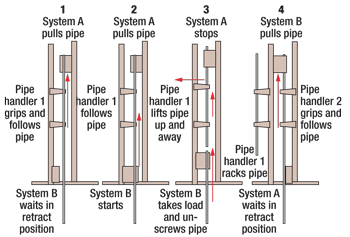
|
|
Two hoisting systems work in sequence to pull or run tubulars in a continuous manner. A tong combined with a tool holder placed on each system breaks out or makes up the connections while hoisting the pipe.
|
|
Running tubulars in and out of a wellbore in a continuous manner has been shown to be feasible through a joint industry project of Statoil, Maersk Drilling and West Drilling Products. The 750-ton Continuous Motion Rig (CMR) has dimensions and weight well within acceptable limits and a tripping speed of 3,600 m/hr. Developed by West Drilling Products, the experimental rig uses a slow but constant pulling or running speed, resulting in significant efficiency gains.
Consider a continuous hoisting speed of 1 m/s, which is about half of the peak speed used per stand in conventional hoisting. However, this constant speed yields 3,600 m, or about 120 normal stands, per hour—compared with 30–40 stands per hour on conventional rigs. A feasibility study was conducted for Statoil and Maersk Drilling of a 750-ton, 3,600-m/hr
design continuous motion rig. Key areas of improvement over current technology are improved tripping speed; improvement in casing running time; possibility of built-in continuous circulation and drilling; personnel safety; wellbore stability; well safety; avoidance of differential sticking; easier automation of the drilling process; improved power consumption and less equipment wear.
The continuous motion technology employs two hoisting systems working in sequence to pull or run tubulars in a continuous manner. A tong combined with a tool holder placed on each system breaks out or makes up the connections while hoisting. Other major components include a slips/elevator system in the tool holder; a top drive placed above the tong on the tool holder (retractable in the tool holder); two pipe handlers that remove or place tubulars into the centerline; two tool carriers (robots) that move vertically along the derrick and place tools into (or remove them from) the centerline at required height; a tool slide in aft that stores and delivers tools to the tool carriers (robots); and a continuous drilling and circulating unit.
One hoisting system pulls the drillstring out of the hole in the centerline while the other hoisting system moves down in a retracted position and into position at the drill floor waiting for a full stand to be pulled above the floor. As the tool joint of the stand passes the rotary table, the lower hoisting system moves into center position and takes the load of the drillstring while the tong starts to break out the tool joint and spin it out, releasing the stand.
This is done while moving at a constant speed upward. Simultaneously, as the lower system takes the load of the string, the pipe handler takes hold of the stand now moving up above the drill floor and has a firm pull on the stand, lifting it up and away from the centerline as soon as the stand is released.
The upper hoisting system stops when the load is taken by the lower system. The tong of the upper system opens to let the pipe handler move the stand out of the centerline when the stand releases. The upper system then retracts and moves down to the drill floor to repeat the sequence, resulting in constant speed of the drillstring.
The sequence is reversed when running tubular into the hole.
Moving the drillstring at constant speed in or out of the hole eliminates pressure fluctuations in the wellbore caused by start/stop accelerations. These pressure fluctuations can be significant depending on well geometry and rig practices, resulting in hole problems and lost time. Avoiding pressure fluctuations when tripping or when running casing will improve well safety by eliminating surge forces.
The next challenge is to solve the question of continuous drilling and circulation. Continuous circulating units are on the market meeting requirements for managed pressure drilling. However, to continuously drill without stopping for connection is considerably more difficult. The two hoisting systems available in the continuous motion rig open up the possibility of continuous drilling and circulation.
Versatile workover unit introduced into Middle East markets
Rodgers Technology’s new Versa-Rig can be used in a range of workover services including underbalanced and directional drilling, live well intervention, completion and well control services, and electrical submersible pump (ESP) replacements. The versatile mobile unit can work either onshore or offshore and on multiwell pads.
|
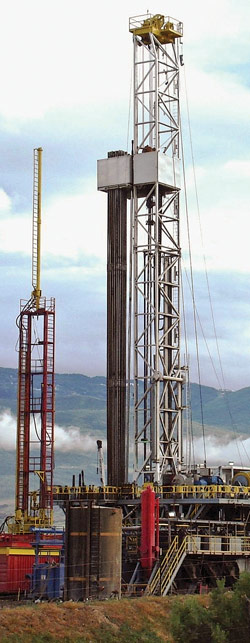
|
|
The small-footprint, self-erecting Versa-Rig workover system is being introduced into Middle East markets after a successful field trial in Colorado’s Piceance Basin.
|
|
Multiple lifting capacities of 170,000, 300,000 and 450,000 lb are available by changing the top cylinder. The rig can drill to 15,000 ft and handle pressures up to 15,000 psi. This range is expected to increase to 750,000 lb in 2011. The workover rig has snubbing capacity to 150,000 lb. It also includes a hands-free makeup and breakout tong.
The small-footprint, self-erecting structure moves the load from the casing head and does not require guidelines to rig up. The unit can be rigged up and operated in close proximity to a drilling rig. Its total weight rests off the casing and on the substructure, significantly reducing the potential of casing failure. When rigged up, the unit can travel on guide tracks in four directions. A mobile trailer-mounted unit is also available. The unit features an Enviro-Tech substructure that houses the power pack and pumps within an 8-in.-deep containment floor to reduce environmental risk.
Designed by Troy Rodgers, the workover system was first operated in the Piceance Basin of Colorado. A total of 39 wells were completed after stimulation with an average of only two days per well, including the time spent moving the workover rig from well to well. Impressed with the results of the operation, Almansoori Petroleum Services of Abu Dhabi signed a joint venture with Rodgers Technology to introduce the rig to Middle East markets.
Seafloor drilling inches closer to reality
An innovative seabed drilling rig is being developed to carry out inexpensive exploration drilling in deepwater or Arctic locations where platform-based exploration costs are high. Advantages of drilling from the seafloor include less dependence on weather, no need for heave-compensation systems, reduced mud backpressure, no rigid riser system and no personnel onboard the rig. A full-scale prototype of the autonomous drill floor, designed by Seabed Rig AS, has been fabricated and is being function tested on land in Stavanger.
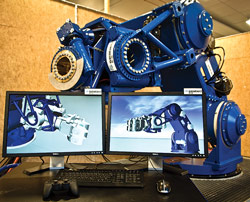 |
|
The seabed rig includes a powerful drill floor robot with 3,000-kg handling capacity.
|
|
An encapsulated and pressure-compensated design ensures zero discharge to sea and the same safety barriers as for conventional drilling. The rig is unmanned, with automated and robotized working operations that are remotely supervised and controlled from an interactive 3D interface. It is assisted by a surface vessel and connected via an umbilical that transports drilling fluids, control cables and power supply.
Development of the rig is supported by Statoil, the Norwegian Research Council and Innovasjon Norge. The autonomous drilling technology and equipment developed for seabed drilling can potentially also be used also in dry drill floor applications.
The drilling equipment consists of a roughneck, robot arm(s), rack-and-pinion lift and pipe handler robot(s), and a top drive.
Each machine holds its own axis controller and a full 3D model of the entire rig. The machines are capable of synchronizing their movements to optimize the overall process and to avoid collisions by continuously broadcasting their status on the local network. A software application in the control center holds a complete 3D model of the entire rig and various machines, which is updated in real time. The interface is easily available for remote connection through a normal Internet connection.
A powerful robot on the drill floor assists in handling and operations. The robot is an all-electrical manipulator with seven axes and 3,000-kg handling capacity. It holds an axes controller that synchronizes and optimizes the movements of the different joints correlated to position and time. The robot can be remotely manipulated by an operator, but is also designed to take inputs in the form of task commands, and independently calculate the optimal paths of movement in order to execute the received commands.
Additionally, a multipurpose manipulator, called the HandyHand, has been developed with human-like characteristics. This tool has fingers that can be orientated and controlled to grab a wide variety of geometries.
All the tools can be docked and undocked to the robot by using a specially designed tool interface that can hold wireless power and communication, in addition to a rotating shaft applying 5-kW torque to the tool. No assistance is needed for the robot to dock or undock.
Pipe handling will be performed by one or two robots located between the lift and the pipe magazines. These robots are, in principle, clones of the drill floor robot with regard to the control system, but with a different mechanical layout. They are equipped with patented grippers that can handle both drill pipe and casing.
The hoisting machinery consists of an all-electric rack-and-pinion system holding an electric top drive. The hoisting machinery and the top drive have the same lifting and torque capabilities as conventional drilling equipment.
The roughneck is concentric with spinning and torque in the same function. It has a balanced internal lift between the two torque wrenches that allows the system to limit the axial force between the two tool joints. It can also handle non-concentric tool joint alignments. The internal control system keeps track of all parameters and produces a report. All process parameters are verified by two independent systems with dissimilar measurement principles to give the control system full contingency.
|







